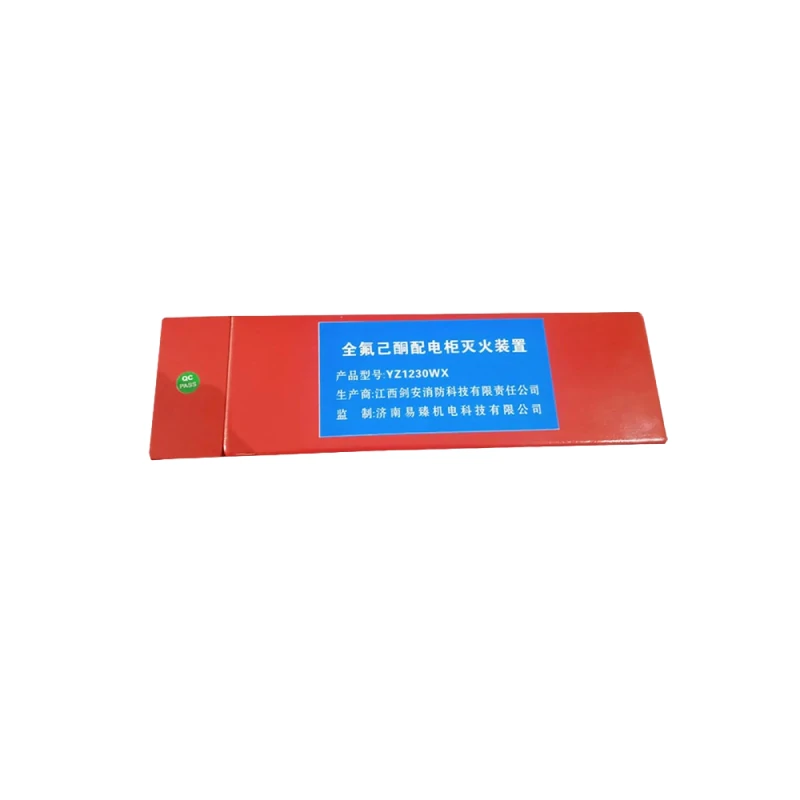
- Advantages: good environmental performance, good fire extinguishing effect, safe to use, good electrical insulation performance, cooling effect block, no residual fire extinguishing, atmospheric storage and transportation without worry, can extinguish electrical fires
- Fire extinguishing principle: mainly by removing most of the heat from the fire scene to extinguish the fire
- Hotline: 400-915-1190
Product Details
I. Principles of fire extinguishing
It is mainly to extinguish the fire by removing most of the heat from the fire scene, i.e.: after the release of perfluorohexanone fire extinguishing agent, it forms a gaseous mixture with the carrier gas N2, which is very easy to absorb or consume a large amount of heat, so as to extinguish the flame temperature quickly and realize efficient fire extinguishing.
II. Main advantages
1, good environmental performance: green environmental protection gas;
2、High fire extinguishing efficiency: low fire extinguishing concentration can quickly extinguish the fire;
3. Safety in use: no cases of low toxicity have been observed;
4, good electrical insulation properties: ordinary wire and cable does not cause damage to the insulator;
5, fast cooling effect: fire extinguishing agent sprayed with a unique cooling effect;
6, extinguish the fire without residue: in the use of rapid evaporation, will not cause damage to precision instruments, antique paintings and calligraphy;
7, atmospheric storage and transportation without worry: liquid at room temperature, can be transported as ordinary goods, easy to fill, transportation and storage;
8, can extinguish electrical fires, solid surface fires, liquid fires and gas fires that can cut off the gas source before extinguishing.
III. Existing types and specifications
Customizable as per customer's requirement.
IV. Main parameters
1. Melting point: -108°C;
1. Boiling point: 49°C
2. Density: 1,6 g/cm3;
3、Liquid viscosity: (0℃/25℃), Mpa-s: 0.56/0.39;
4, insulation performance (110Kv): 3.8mA (standard value leakage current ≤ 10mA);
5. Non-volatile residue %: ≤0.01;
6. Design concentration %: 3.5-5.5;
7, fire extinguishing spraying time: general protection area ≤ 10s, communication room and electronic computer room and other protective areas ≤ 8s;
8. Rated boost pressure:
Class I 2.5±0.1MPa gauge pressure; Class II 4.2±0.1MPa gauge pressure.
9. Unit filling rate in extinguishing agent storage containers:
(b) For primary pressurized storage packagings, not more than 1480 (Kg/m3); for secondary pressurized storage packagings, not more than 1440 (Kg/m3).
10. The water content of nitrogen should be less than 0.006%;
11. Design temperature of fire extinguishing system: 20℃;
12. Design of fire extinguishing concentrations in special places:
(1) Protected areas such as books, archives, bills and artifact repositories, etc., extinguish fires with a design concentration of 101 TP3T.
(2) Oil-immersed transformer rooms. Protected areas such as distribution rooms with oil switches and self-contained generator rooms are designed to extinguish fires with a concentration of 9%.
(3) Protected areas such as communication rooms and electronic computer rooms, extinguishing design concentration 8%.
V. Areas of application (places)
Widely used in the whole area or local area fire extinguishing system and portable fire extinguishers, especially suitable for electronic control centers, computer rooms, power distribution rooms, distribution cabinets, wind power machine rooms, energy storage power stations, advanced precision instruments, museums, data processing centers, ship control engine room, new energy vehicles lithium batteries, subway stations, large supermarkets, public places and other places such as protection and other occasions of fire protection.
Not applicable to material fires in the following locations:
1. Nitrocellulose, sodium nitrate and other oxidizers or chemicals containing oxidizers fire;
2. Potassium, magnesium, sodium, titanium, zirconium, uranium and other active metal fires;
3. Metal hydride fires such as potassium hydroxide and sodium hydroxide;
4. Chemical fires that can decompose on their own, such as hydrogen peroxide and even amines;
5. Deep-seated fires in combustible solids.




